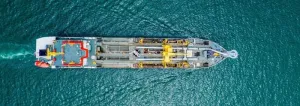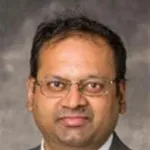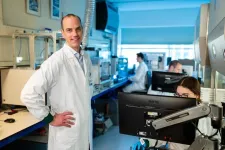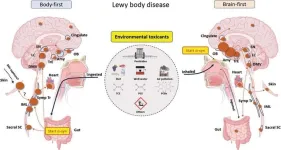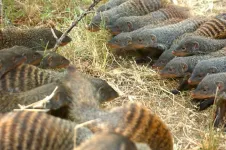(Press-News.org) The maritime profession is among the world’s oldest professions, and today’s shipping is based on long and proud traditions. Professional pride and commitment are often deeply ingrained in seafarers, and for many, the job is more of a way of life. New technologies will bring about major changes in the work of bridge officers, who have the ultimate responsibility on board Norwegian vessels.
Strong doubts about safety
“Bridge officers rely on automated systems that are already found on board, such as advanced autopilot systems. However, there is strong scepticism, almost mistrust, that increased automation and autonomous (i.e. self-driving) ships will contribute positively to safety.”
This is the opinion of Asbjørn Lein Aalberg, a PhD candidate at the Norwegian University of Science and Technology (NTNU’s) Department of Industrial Economics and Technology Management and SINTEF Digital.
In his doctoral work, he has studied the relationship between maritime officers’ professional commitment and the attitudes they have towards automation and autonomous ships. The study ‘Pride and mistrust? The association between maritime bridge crew officers’ professional commitment and trust in autonomy’ was recently published in the WMU Journal of Maritime Affairs. The research was conducted in collaboration with the Norwegian Maritime Authority and Safetec.
Over 8000 Norwegian bridge officers participated in the 2023 survey (in Norwegian). This is probably the largest survey in this field to date, also internationally.
Looking for the reasons behind the scepticism
Sooner or later, society must accept using modes of transport such as passenger ferries that have little or no crew on board. Aalberg believes that in order for operations to be as safe as possible, employees are needed who know how to control and monitor the automation.
“If we are to get there, it is important to understand what is behind the seafarers’ scepticism. We need their engagement, willingness and interest to ensure that the technology and systems being developed are fit for purpose,” says the researcher.
The reason why bridge officers trust autopilots and similar systems is that they themselves are still in control and can choose to turn the systems on and off as and when they see fit.
Few women in the sample
Aalberg has taken a closer look at the answers given by captains and navigators on board. Collectively, this group consists of 1789 Norwegian and 227 international bridge officers of all ages, with everything from 0 to more than 26 years of experience. Women constitute only 11 per cent of Norwegian seafarers, and only 2.4 per cent of the participants in this survey.
“This probably reflects the fact that there are even fewer women among the people working on the ship’s bridge,” says Aalberg.
Among other things, the bridge officers were asked about:
Their thoughts and feelings about the automation of work tasks
Their confidence in autonomous technology
Their professional commitment and pride
Their own management work related to safety
Seafarers with an extreme sense of duty
Aalberg says that bridge officers are very proud of their work and exhibit what he would call a rather extreme sense of duty to their own profession.
“This pride may lead to additional mistrust when faced with radical changes. In fact, we found that those who take the greatest pride in their profession are most sceptical about technological developments,” says the researcher.
Another finding that he finds quite alarming is this: among the bridge officers who take the greatest pride in their profession, it is the younger ones who have the least faith in autonomy.
“When envisioning their future career, maybe they feel like they have more to lose,” says Aalberg.
You might also like: Test site opens for unmanned vessels
One of the oldest professions in the world
This area has seen little research, and Aalberg says we don’t currently know enough about why seafarers exhibit such strong mistrust. One reason for this is that there are currently not many autonomous ships, and they are a hot topic of speculation and debate. It is therefore important to emphasise that points of view may be based on rumours, vague impressions and unfounded notions of what the changes will entail.
It is also often the case that autonomous vessels are spoken positively about by actors who are relative newcomers to the maritime industry. The survey indicates that this could spark uncertainty among seafarers, both in terms of the motives and intentions behind autonomy.
“Despite the fact that there seems to be a great need for seafarers in the future, some people may be afraid of losing their jobs. But I think the scepticism is more about the changes being made to the nature of their work. For example, there would be a great deal of uncertainty among captains if the position were to lose its independence. We must not forget that the maritime profession has a very long tradition, where a captain’s authority and control have always been strong,” says Aalberg.
Professional discretion
The PhD candidate has also interviewed 31 Norwegian seafarers on board highly automated Norwegian passenger ferries about their confidence in the advanced automated systems that have been installed. This study gives some hints about what it takes for bridge officers to trust advanced technology. Among other things, it involves their lack of trust in the machines’ ability to demonstrate true ‘seamanship’ and exercise professional discretion in traffic. In addition, the interviewees do not believe that the machines will manage emergency situations well enough. All in all, they believe that people are best suited to making decisions in complicated situations.
“The reason they still trust autopilots and similar systems is that they themselves have control and the option to turn them on or off as and when they see fit,” says Asbjørn Lein Aalberg.
The shipping company and technology developers have also had a very long and ultimately successful development process that he believes is needed to satisfy proud seafarers.
However, all the informants were sceptical about the impending changes and expressed concern that increased automation would compromise safety at sea.
Autopilot is ok, autonomy is not
The studies show that bridge officers make a clear distinction between automation and autonomy. Automation involves machines taking over some of their tasks, while autonomy, taken to its ultimate conclusion, means unmanned ships.
Asbjørn Lein Aalberg provides a nuanced perspective on the development.
“Many researchers argue that humans will play a crucial role in human-automation collaboration, even on autonomous ships. Previously, there was more talk about removing people all together, to put it bluntly,” says the researcher.
Seafarers must be consulted
He hopes the authorities can use the results of the research in dialogue with shipping companies and technology providers. He says they should include seafarers when developing new concepts and technological solutions.
“They have to make, and talk about, innovations in such a way that it sparks interest instead of scepticism,” he says.
He also believes that projects involving technological development should openly disseminate real results from testing in order to provide a nuanced perspective of what seafarers perceive as being overly idealised.
“We also know that seafarers gain trust in advanced technology by trying the technology themselves. Keynote speakers or even colleagues talking about the systems is simply not enough. They want to try them themselves and see if the automation makes the same choices that they would have made, so perhaps the development process should be structured accordingly," Aalberg says.
REFERENCES:
Aalberg, A.L. Pride and mistrust? The association between maritime bridge crew officers’ professional commitment and trust in autonomy. https://doi.org/10.1007/s13437-024-00329-6
Asbjørn Lein Aalberg, Siri Mariane Holen, Trond Kongsvik, Aud Marit Wahl. Does it do the same as we would? How trust in automated shipboard systems relates to seafarers’ professional identity https://doi.org/10.1016/j.ssci.2024.106426
END
Proud seafarers have strong doubts about the safety of autonomous ships
In spite of relying on advanced autopilot systems, bridge officers are skeptical of fully autonomous ships
2024-04-11
ELSE PRESS RELEASES FROM THIS DATE:
People who use willpower alone to achieve goals, resist temptation, deemed more trustworthy
2024-04-11
People who use willpower to overcome temptations and achieve their goals are perceived as more trustworthy than those who use strategies that involve external incentives or deterrents – such as swear jars or internet-blocking apps – according to research published by the American Psychological Association.
“The knowledge that people can use external commitment strategies to overcome self-control problems has existed in some form for thousands of years. Since at least the time of Homer and Odysseus, the focus has primarily been on the efficacy of these strategies for the person choosing to engage ...
New study shows effect of socio-economic factors—housing, food, neighborhood—to predict diabetic patients’ risk of heart failure
2024-04-11
CLEVELAND—A recent study by Case Western Reserve University used national data from U.S. military veterans with diabetes to validate and modify a widely accepted model used to predict the risk of heart failure in diabetic patients.
The model, called the WATCH-DM score, is used to predict the likelihood of heart failure in diabetes patients within five years.
But because it overlooks the influence of social determinants of health‚ such as housing, food and a patient’s neighborhood, the researchers used a social deprivation index (SDI), a multi-component summary score, to adjust the WATCH-DM score.
The SDI, introduced by the Robert ...
Mapped: 33 new big game migrations across American West
2024-04-11
RESTON, Va. — A new set of maps that document the movements of ungulates was published today in the fourth volume of the Ungulate Migrations of the Western United States. The maps in this collaborative U.S. Geological Survey report series reveal the migration routes and critical ranges used by ungulates, or hooved mammals, in the western U.S., furthering scientists’ understanding of the geography of big game migrations.
The new volume, “Ungulate Migrations of the Western United States: Volume 4,” documents 33 mule deer, ...
Can we crack the code of cartilage?
2024-04-11
Can Jos Malda crack the code of cartilage?
In our aging society, healing joint problems is becoming increasingly important. To do this, cartilage damage must become repairable. But so far it has proven impossible to recreate the intricate internal structure of cartilage. Professor Jos Malda has now received an ERC Advanced grant of €2.5 million to crack that code.
Bringing biology and technology together
Throughout his career, Jos Malda has been concerned with the interface between biology and technology. It took him from studying Bioprocess Engineering in Wageningen to ...
Moments of clarity in the fog of dementia
2024-04-11
A recent Mayo Clinic study published in Alzheimer's & Dementia: The Journal of the Alzheimer's Association investigated lucid episodes in people living with later stages of dementia, providing insights into how these occurrences reveal themselves.
The findings showed that 75% of people having lucid episodes were reported to have Alzheimer’s Disease as opposed to other forms of dementia.
Researchers define lucid episodes as unexpected, spontaneous, meaningful and relevant communication from a ...
Heart transplant recipient discovers a calling for advocacy, support for others
2024-04-11
11 April, Prague, Czech Republic—Glen Kelley’s journey as a heart transplant recipient came full circle today in Prague, as he addressed attendees of the Annual Meeting and Scientific Sessions of the International Society for Heart and Lung Transplantation (ISHLT), including members of his own care teams.
As a high school senior outside of Peoria, Illinois, Kelley was diagnosed with stage-4 Hodgkin’s lymphoma and underwent eight months of chemotherapy and radiation. After 10 months in remission, the ...
On World Parkinson’s Day, a new theory emerges on the disease’s origins and spread
2024-04-11
The nose or the gut? For the past two decades, the scientific community has debated the wellspring of the toxic proteins at the source of Parkinson’s disease. In 2003, a German pathologist, Heiko Braak, MD, first proposed that the disease begins outside the brain. More recently, Per Borghammer, MD, with Aarhus University Hospital in Denmark, and his colleagues argue that the disease is the result of processes that start in either the brain’s smell center (brain-first) or the body’s intestinal tract (body-first).
A new hypothesis paper appearing in the Journal of Parkinson’s ...
ERC wants to see what shapes the stories AI tells us
2024-04-11
Professor Jill Walker Rettberg, Co-Director of the Centre for Digital Narrative at the University of Bergen, is awarded an ERC Advanced Grant for the project AI STORIES. The grant consists of 2.5 million Euro over 5 years. This is Rettberg's second ERC Grant.
“The AI STORIES project builds on the premise that storytelling is central to human culture, with narratives shaping our understanding of the world. We will study artificial intelligence and how it creates new narratives,” says Rettberg.
Generative AI has been dubbed ...
New project explores warfare in animal societies
2024-04-11
A major new research project will investigate how and why groups of animals from the same species fight one another.
By focussing on warlike species – mongooses and termites – researchers aim to understand how evolution can lead to extreme aggression between groups, the consequences of this and the factors that can lead to peace.
The results will help to explain why violence between rival groups evolves in some species but not others, or between some groups and not others – with implications for our understanding of human evolution.
The research team, led by Professor ...
Mirta Galesic awarded ERC Advanced Grant
2024-04-11
[Vienna, April 11, 2024] – The European Research Council (ERC) has awarded an Advanced Grant to Mirta Galesic, a resident scientist at the Complexity Science Hub (CSH), to study the intricate workings of collective adaptation. The project aims to provide insights into why collectives – from families to entire societies – can be stuck in deadlocks about important problems, such as resolving long-standing political conflicts; or why they sometimes appear incapable of finding seemingly obvious solutions, such ...
LAST 30 PRESS RELEASES:
Norbert Holtkamp appointed director of Fermi National Accelerator Laboratory
New agentic AI platform accelerates advanced optics design
Biologists discover neurons use physical signals — not electricity — to stabilize communication
Researchers discover that a hormone can access the brain by hitchhiking
University of Oklahoma researcher awarded funding to pursue AI-powered material design
Exploring how the visual system recovers following injury
Support for parents with infants at pediatric check-ups leads to better reading and math skills in elementary school
Kids’ behavioral health is a growing share of family health costs
Day & night: Cancer disrupts the brain’s natural rhythm
COVID-19 vaccination significantly reduces risk to pregnant women and baby
The role of vaccination in maternal and perinatal outcomes associated with COVID-19 in pregnancy
Mayo Clinic smartwatch system helps parents shorten and defuse children's severe tantrums early
Behavioral health spending spikes to 40% of all children’s health expenditures, nearly doubling in a decade
Digital cognitive behavioral treatment for generalized anxiety disorder
Expenditures for pediatric behavioral health care over time and estimated family financial burden
Air conditioning in nursing homes and mortality during extreme heat
The Alps to lose a record number of glaciers in the next decade
What makes a good proton conductor?
New science reporting guide published for journalists in Bulgaria
New international study reveals major survival gaps among children with cancer
New science reporting guide published for journalists in Turkey
Scientists develop a smarter mRNA therapy that knows which cells to target
Neuroanatomy-informed brain–machine hybrid intelligence for robust acoustic target detection
Eight SwRI hydrogen projects funded by ENERGYWERX
The Lundquist Institute and its start-up company Vitalex Biosciences Announces Strategic Advancement of Second-Generation fungal Vaccine VXV-01 through Phase 1 Trials under $40 Million Competitive Con
Fine particles in pollution are associated with early signs of autoimmune disease
Review article | Towards a Global Ground-Based Earth Observatory (GGBEO): Leveraging existing systems and networks
Penn and UMich create world’s smallest programmable, autonomous robots
Cleveland researchers launch first major study to address ‘hidden performance killer’ in athletes
To connect across politics, try saying what you oppose
[Press-News.org] Proud seafarers have strong doubts about the safety of autonomous shipsIn spite of relying on advanced autopilot systems, bridge officers are skeptical of fully autonomous ships
